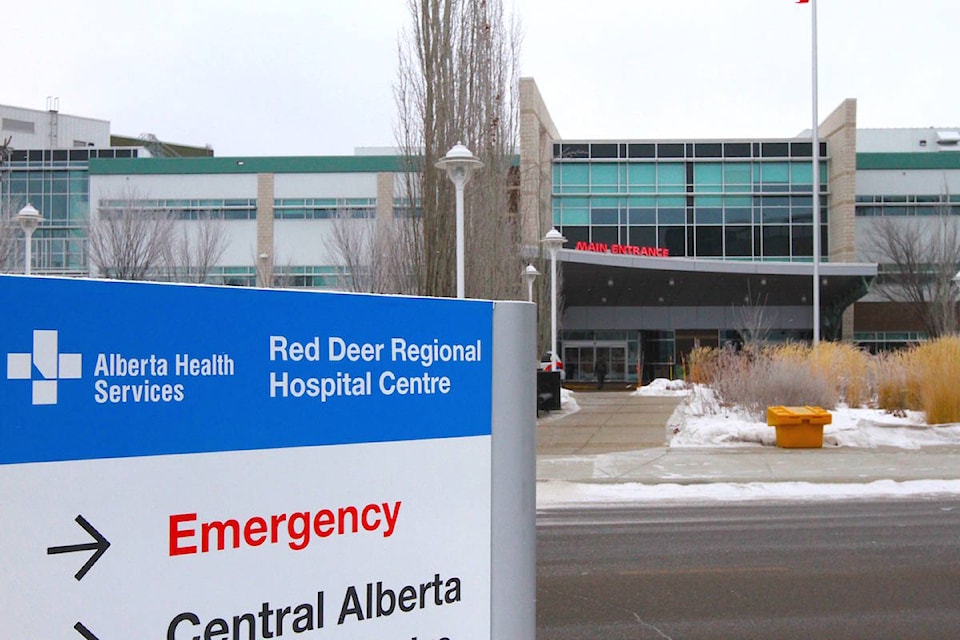A 61-year-old mother and her daughter experienced first hand the lack of capacity at Red Deer Regional Hospital Centre.
Cassandra Tataryn, of Red Deer, said her mother was on a stretcher in a hallway on Monday night for about six hours waiting to be admitted into a hospital bed, before she decided to leave with family, who took her to an Edmonton hospital.
The Red Deer hospital has been struggling to find space for patients since overcapacity escalated Monday.
Alberta Health Services said the hospital initiated overcapacity Level 3 protocols on Monday, which continued Tuesday. Level 4 is the highest measure.
The Level 3 protocols, which include transferring patients to other facilities, were developed for when hospitals experience a high number of seriously ill patients.
AHS said the overcapacity process was refined in June 2019, and Level 3 has been initiated seven times since then in Red Deer.
Tataryn said it was her mother’s second trip back to Red Deer hospital because of complications from day surgery performed last week.
Tataryn said Red Deer needs a bigger hospital and more staff to provide timely care.
“When is the last time we had an expansion? We have this new parkade. The cars are safe, but what about the people?
“They need to build onto it, or else expand the services in Lacombe or Innisfail, so that people can go there,” Tataryn said.
Related:
Red Deer hospital experiencing ‘capacity challenges’ this week, says Alberta Health Services
Alberta nixes panel recommendation to close five rural hospitals, trauma centre
AHS said it understands that waiting to be admitted to hospital is challenging and can be frustrating.
“Winter is traditionally a busy time of year for health-care services, and it is not unusual to see an increased demand in emergency departments, including at Red Deer Regional Hospital Centre.
“We empathize with patients or family members who may have concerns about wait times in the emergency department,” said AHS in a statement to the Advocate.
“Be assured the emergency department remains open. No one has been, or will be, turned away. Critically ill or injured patients will always be seen immediately, and those with non-urgent concerns may wait longer to be seen, depending on resources.”
Tataryn said maybe nurses and doctors should take a small pay cut, and the extra money put toward hiring more staff and building a larger facility to prevent overcapacity that causes problems for both health-care workers and patients.
Tataryn said if staff are really concerned about helping patients, less pay should not be a problem for them.
A report released Monday that had been ordered by Alberta Health had 57 recommendations that included changes to pay for doctors and nurses to cut costs at facilities across the province by $1.9 billion per year.
Heather Smith, president of the United Nurses of Alberta, said every occupation in Alberta, including nurses, is paid more than in other provinces, with the exception of the arts.
But paying nurses less does not mean more nurses would be hired, she said.
“It’s unfortunate that this woman experienced overcapacity, but there is absolutely no suggestion, or indication, that if nurses, or other health-care workers, would consider or take a wage rollback, that it would result in better staffing.
“What the report yesterday said is that Albertans can expect lesser staffing in many areas of the system,” Smith said.
Last year, the provincial government announced plans to eliminate 500 nursing positions over three years, which may involve closing acute care beds as more continuing care beds open.
Smith said as part of its contract negotiations, the union wants public disclosure of how often overcapacity occurs, which is a huge issue across the system, particularly in urban settings.
“I think the public has the right to know how much overcapacity exists currently, which is an indication of how much capacity we actually lack, especially when there’s talk about actually closing acute care beds.”
szielinski@reddeeradvocate.com
Like us on Facebook and follow us on Twitter
